Events of Friday 21st February 2020
The visit to Ureparapara was added to the programme only two days previously, when Noble Caledonia decided that the planned visits to the Solomon Islands were no longer viable. Overnight, the ship had sailed from our previous mooring off Ambryn Island around 170 nautical miles to Ureparapara.
The island is a large, volcanic caldera which has collapsed on one side, allowing the surrounding sea to flood the cone, producing a horse-shoe shaped island. Deception Island in Antarctica (which I’ve visited a couple of times in 2007 and then 2016) has similar origins.
Many of the passengers were on deck as the ship made its entrance to the caldera at Ureparapara.

View from 'Caledonian Sky' as we approach the flooded caldera: Ureparapara, Vanuatu.
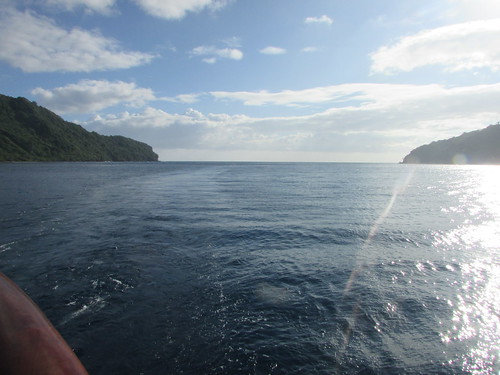
View of open sea from 'Caledonian Sky', inside the flooded caldera: Ureparapara, Vanuatu.
At 08:45, the ship started taking passengers ashore by Zodiac for a wet landing into the shallows of a narrow beach area of black, sticky mud-like volcanic sand.

View from Zodiac as we go ashore at Ureparapara, Vanuatu.
A group of impressive male dancers welcomed us, moving to the beat of a hand-held percussion bamboo instrument. All the men were painted all over in black with white rings around torso, arms and legs. They wore grass skirts and large clusters of sea shells around each ankle, producing a distinctive accompaniment as they stamped the ground. Young children from the village nearby watched the proceedings with interest.

Male dancers painted all over in black with white rings around torso, arms and legs on Ureparapara, Vanuatu.

A group of children on Ureparapara, Vanuatu.
Nearby, a group of more modern musicians were playing and singing. There was one bongo drummer, three acoustic guitars and one small 4-string banjo-like locally-made instrument. Like almost all the men, they were dressed in colourful tee-shirts with shorts but the musicians were also adorned with headbands carrying hibiscus flowers.
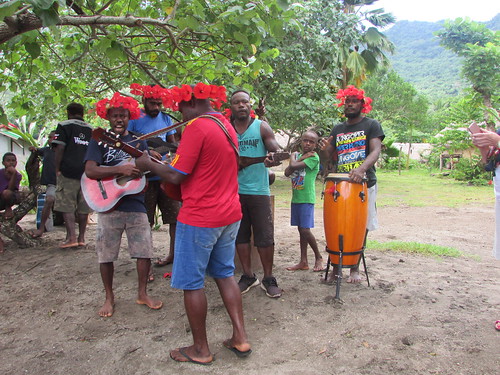
A group of modern musicians playing and singing on Ureparapara, Vanuatu.
There had been a ‘USAID’ project here for a large sign carried the project title ‘Land and Vegetation Cover and Improving Food Security for Building Resilience to a Changing Climate in Pacific Island Communities’. The rest of the sign was in Bismala, the Pidjin language widely understood in Vanuatu. There's a list of English-based Pidjins on Wikipedia here and Bislama is discussed in the interesting Wikipedia article here.
We walked towards the village, where the most buildings were timber framed, with woven bamboo walls and thatched roofs, either erected on a small plinth of flat stones or lifted a few inches above the ground.

House under construction, Ureparapara, Vanuatu

Ureparapara, Vanuatu.
The church of Saint Barnabas was a slightly more substantial construction with a sawn timber frame and corrugated sheet roof but still retaining woven bamboo panels for the walls. A large gas cylinder standing vertically nearby served as the church bell.
A group of kneeling young boys in grass skirts were playing a pebble-tossing game in a small, square area marked-out by four straight poles.
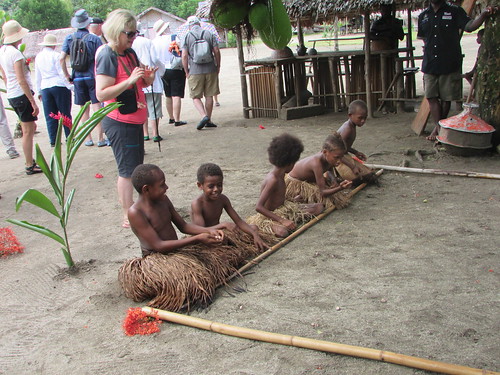
Young boys playing a pebble-tossing game on Ureparapara, Vanuatu.
All the visitors were seated in wooden stands around a performance area. The end bench seat quite near me suddenly collapsed as people tried to sit.

Collapse of bench seat, Ureparapara, Vanuatu.
Various locally-made benches and chairs quickly appeared and everybody was successfully seated. I couldn't resist the suspicion that this minor incident was symptomatic of a laid-back approach to life by the hospitable islanders.
First, a group of nine ladies in grass skirts danced for us.

Female dancers, Ureparapara, Vanuatu
Next, three men formed a percussion band. The hand-held bamboo instrument we’d seen as we arrived was now fixed between two waist-high poles and supplemented by two other musicians - one with what looked like some sort of gourd with seeds inside which was shaken and the other with a long pole held upright and struck against a baseplate laid on the ground. In the meantime, the ladies had each armed themselves with bamboo staffs.

Lady dancers chat as three musicians prepare: Ureparapara, Vanuatu.
Ten male dancers then performed, all wearing grass skirts with a thin cloak made from long plant fronds and with clusters of sea shells around each ankle. Each wore distinctive headgear, representing different aspects of life on the island.

Ten male dancers, each with headgear representing different aspects of life on Ureparapara, Vanuatu.
The ship's passengers then continued to explore the village. Another band started to play. The musicians were in modern dress but plus the thin cloak made from plant fronds. The line-up was drummer, two men each playing a sort of Pan-Pipe with four notes and four men each playing an instrument similar to a xylophone comprising ten bamboo pipes, each a different length, assembled together on an inclined frame. The note was struck by striking the open top of the desired bamboo pipe with a paddle. The overall effect was splendid.
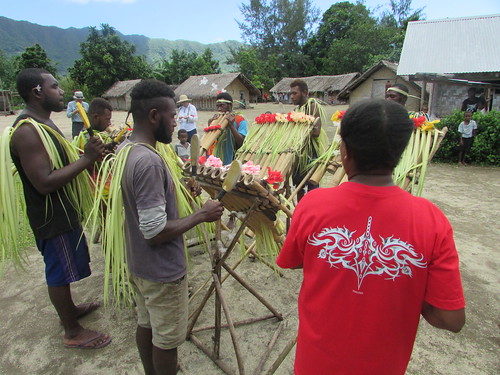
The Band: Drum, Pan Pipes and four bamboo xylophones: Ureparapara, Vanuatu.
At a shelter next to the band, fruit and fresh coconut milk was offered to the visitors. A couple with a child, all in traditional dress, prepared a local dish, inevitably involving coconut, which was then offered to the ship’s passengers.

A couple with a child offered local food to the visitors: Ureparapara, Vanuatu.
Near the sea, an elaborate diagrammatic map of the village had been created with pebbles set in clean sand, decorated with hibiscus and other blooms. I presume the 'Store' is what the the english call a 'Shop'. The 'Nakamal' is the men's hut where men relax and drink Kava. I assume 'Keeping House' refers to a store house.
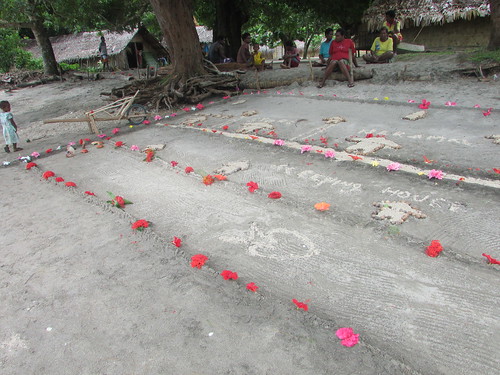
A diagrammatic map of the village had been created with pebbles set in raked sand: Ureparapara, Vanuatu.
It was a very friendly, relaxed visit and we spent some time just chatting to the villagers and listening to the live music. Eventually we moved towards the Zodiac landing place and, by noon, we had transferred back to the ship after a very enjoyable visit to Ureparapara.
Related posts on this website
This post is in the series labelled 'Tropic of Capricorn’. The first post is here.
Clicking on the 'Next report' link will display the post describing the next events. In this way, you may read about the trip in sequence.
Next report
Alternately, clicking on the 'All my Tropic of Capricorn reports' link displays all the posts on this trip in reverse date-of-posting order.
All my Tropic of Capricorn reports
My pictures
This blog post was first published on the ship via a satellite link with limited capacity so the link to my pictures was added later.
Ureparapara, Vanuatu
[Link to pictures added 11-Mar-2020: Pictures embedded 31-Mar-2020]
